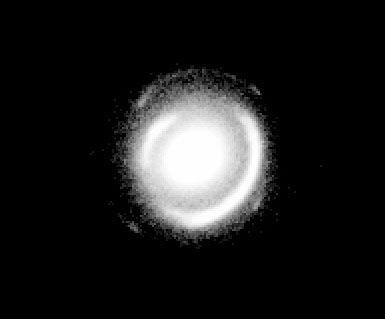
Background
Before Fritz Zwicky came up with the revolutionary idea of Dark Matter, scientists only associated matter with the light of luminous stars. With the data available before Fritz's time, it was logical to assume that galaxies with many stars (brightly shining) contained more matter and had higher masses than galaxies with only a few stars (faintly glowing). Fritz found a flaw in this theory by studying the Coma Cluster, a group of over 3,000 galaxies. Here is an excellent overview of his groundbreaking discovery:
"The average speed of galaxies within a cluster depends on the total mass of the cluster, since each galaxy is attracted by the gravity of all the others. From the observed speeds of galaxies moving within the Coma cluster, Zwicky calculated its total mass. He then added up all the light from the galaxies in the cluster and used it to calculate the mass in the form of luminous stars. To his surprise, the mass of the cluster based on the speed of its galaxies was about ten times more than the mass of the cluster based on its total light output. He concluded that the Coma cluster must contain an enormous quantity of unseen matter, with enough gravity to keep the rapidly moving galaxies from flying apart. Zwicky in effect discovered that most of the mass in the universe is invisible. He called it 'dark matter'" (4).
Detection
Research has continually supported Fritz’s conclusion and initial study. Below are explanations of two recent studies that have also shown evidence of the existence of dark matter. We are using both of these methods to complete our research.
Mass to Luminosity Ratios – When the mass of a galaxy is divided by it’s luminosity, the resulting ratio determines if dark matter is present. Remember: before Fritz, scientists only associated matter with the light of luminous stars (many stars =brightly shining = lots of matter = high mass OR few stars =faintly glowing = little matter = low mass). Theoretically, this presumption would always produce a ratio equal to or less than one. Now that we can actually calculate a galaxy’s mass and lumiosity, we can use the ratio accurately, and it usually ends up to be greater than one. The extra mass, with no added luminosity, implies the existence of non-visible matter (a.k.a. dark matter).
 Gravitational Lensing –Massive objects in space, like galaxies, can actually bend light. If another massive object lies directly behind one being observed, the light from behind will bend around the nearer one. The mass of a galaxy alone, however, does not generate enough gravity to alter the path of light. Therefore, dark matter must exist around galaxies. It must be generating the extra gravity needed to bend light. To the left is an image of a rare lensing galaxy. It has two rings because it is bending the light of two massive objects.
Gravitational Lensing –Massive objects in space, like galaxies, can actually bend light. If another massive object lies directly behind one being observed, the light from behind will bend around the nearer one. The mass of a galaxy alone, however, does not generate enough gravity to alter the path of light. Therefore, dark matter must exist around galaxies. It must be generating the extra gravity needed to bend light. To the left is an image of a rare lensing galaxy. It has two rings because it is bending the light of two massive objects.
Conclusion
Dark Matter is everywhere, and is therefore the key to unlocking more secrets of the universe. Scientists have calculated that “95% of the mass of galaxies and clusters is made of some unknown component of Dark matter ” (3). Such an enormous percentage indicates that dark matter must be an important building block of the universe. Studying dark matter helps us determine the shape, age, and size of our universe.
Works Cited
1. "Coma Cluster/ Super Cluster." Solstation.com. Sol Company. Web. 17 Aug. 2011. <http://www.solstation.com/x-objects/coma-sc.htm>.
2. "Dark Matter/Dark Energy." Abyss.uoregon.edu. Web. 17 Aug. 2011. <http://abyss.uoregon.edu/~js/ast123/lectures/lec16.html>.
3. Freese, Katherine. "Review of Observational Evidence for Dark Matter in the Universe and in Upcoming Searches for Dark Stars." Diss. University of Michigan, 2008. Arvix.org. Web. 17 Aug. 2011. <http://arxiv.org/PS_cache/arxiv/pdf/0812/0812.4005v1.pdf>.
4. "Fritz Zwicky's Extraordinary Vision." Amnh.org. Ed. Steven Soter and Neil D. Tyson. Web. 17 Aug. 2011. <http://www.amnh.org/education/resources/rfl/web/essaybooks/cosmic/p_zwicky.html
